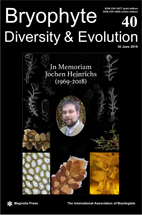Abstract
The origin and early diversification of land plants is one of the major unresolved problems in evolutionary biology. Occurring nearly half a billion years ago, the transmigration of green organisms to land changed the landscape and provided the food source for terrestrial life to invade a vast uninhabited space, adapt and radiate. Although bryophytes (mosses, liverworts and hornworts) are often regarded as the earliest terrestrial organisms, the order of their divergence remains contentious even as molecular analyses become more conclusive with expanded taxon sampling, massive genetic data and more sophisticated methods of analysis (Cox et al. 2018; Morris et al. 2018). Indeed, virtually every combination of relationships among bryophytes has been proposed based on molecules (Qiu et al. 2006; Wickett et al. 2014; Cox et al. 2018). Fortunately, in 2018 it appears that we are approaching a consensus based on molecules, and that is that although bryophytes may or may not be monophyletic, mosses plus liverworts form a natural group (Puttick et al. 2018). In this essay, we point out that this inference is neither new nor surprising as it has been the fundamental conclusion of morphological analyses for over 25 years starting with an exhaustive cladistic analysis of characters associated with motile cell development in green plants (Garbary et al. 1993).

